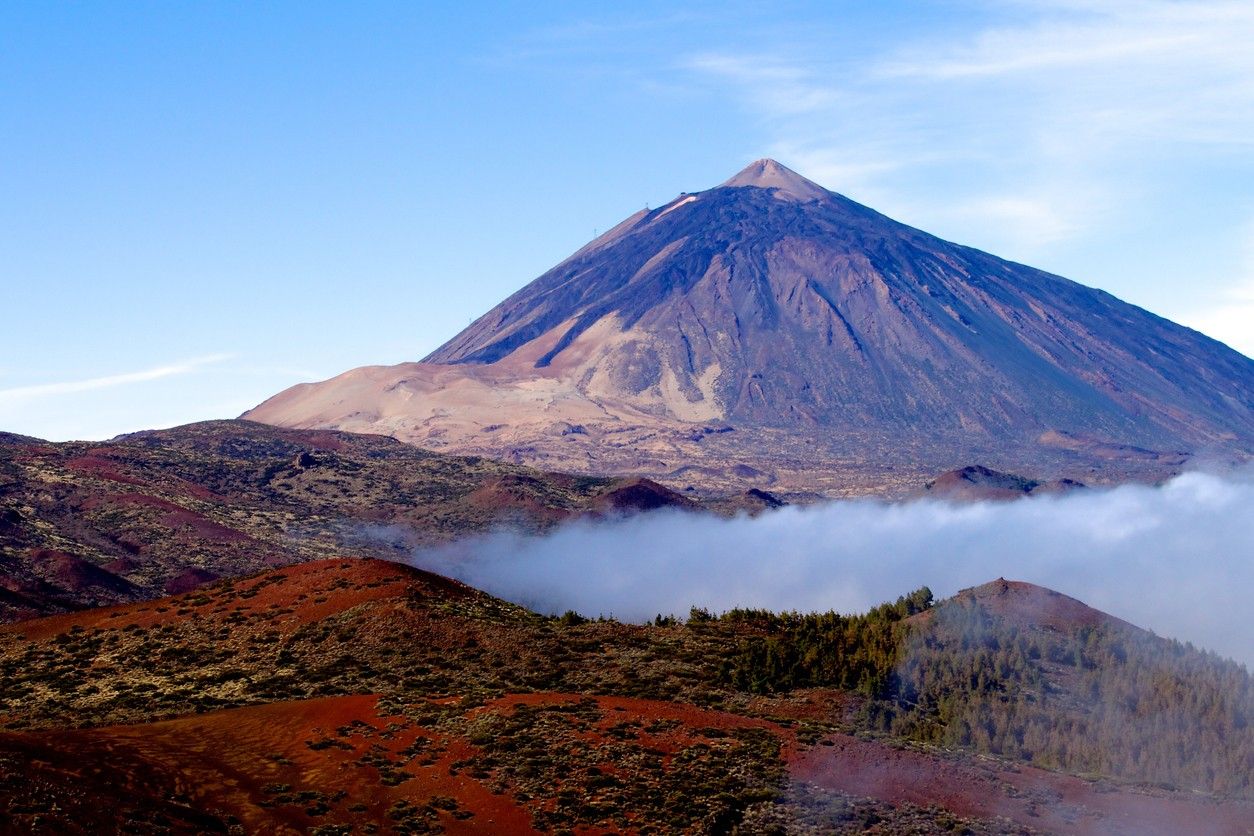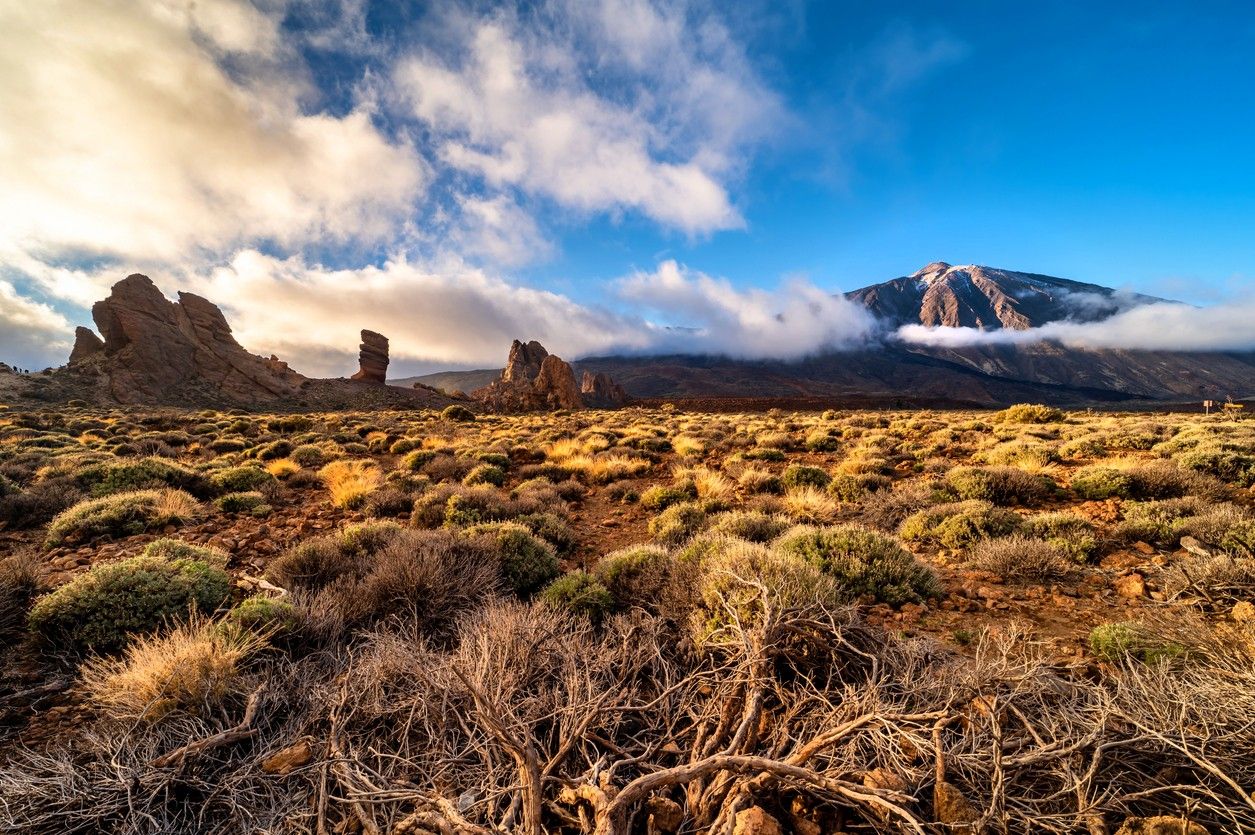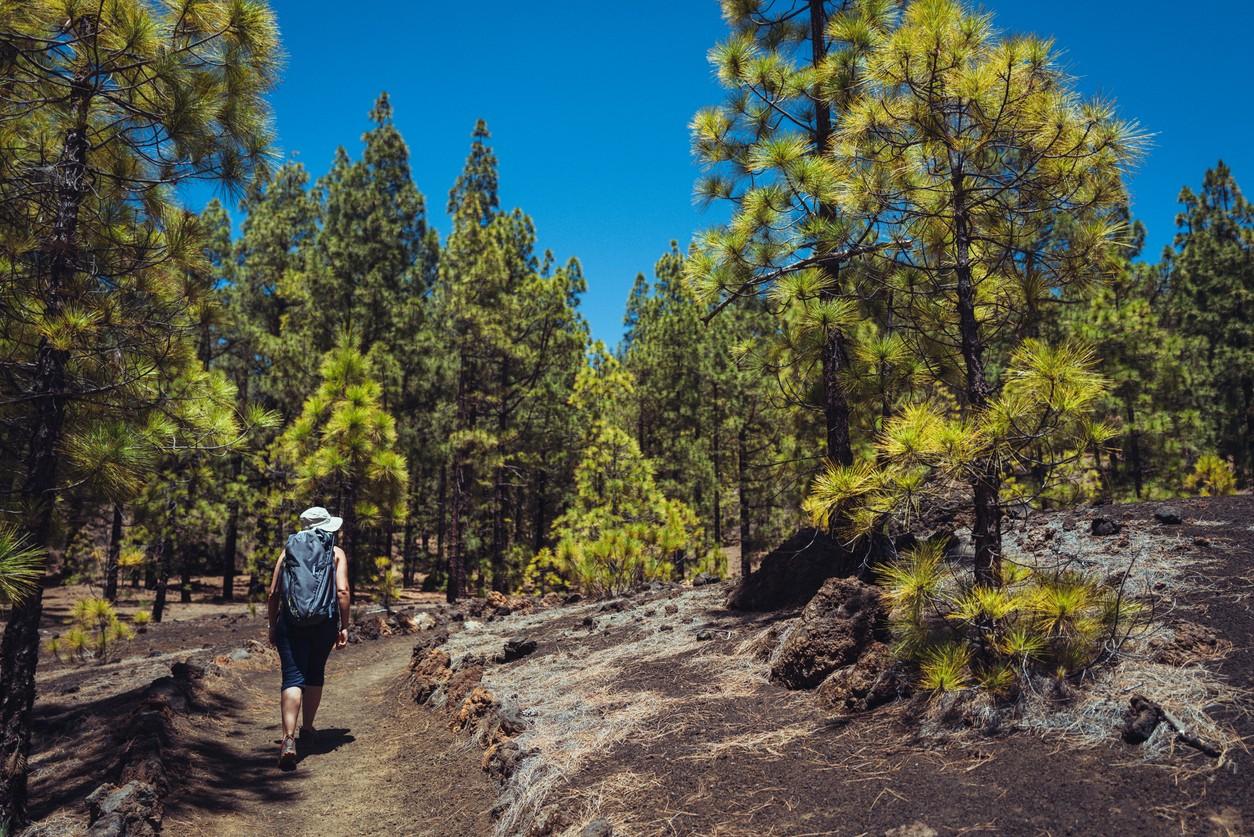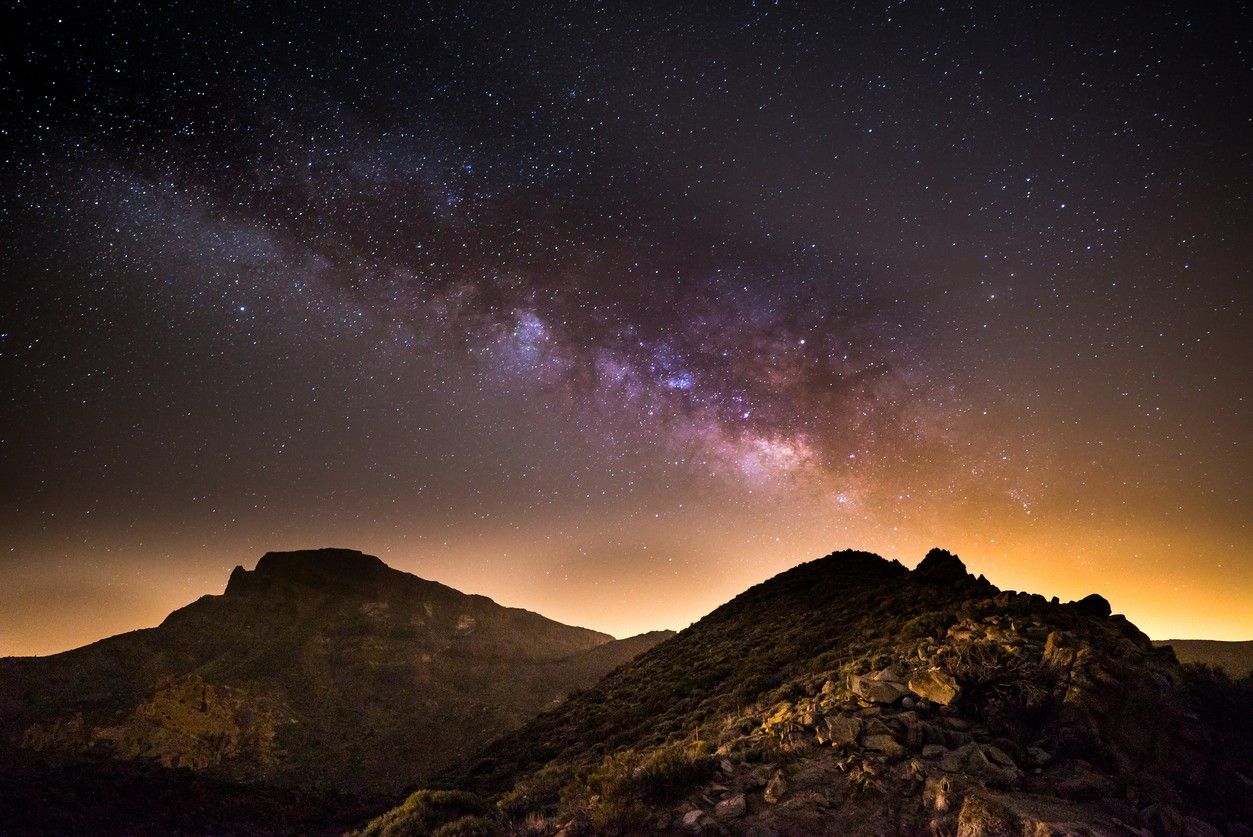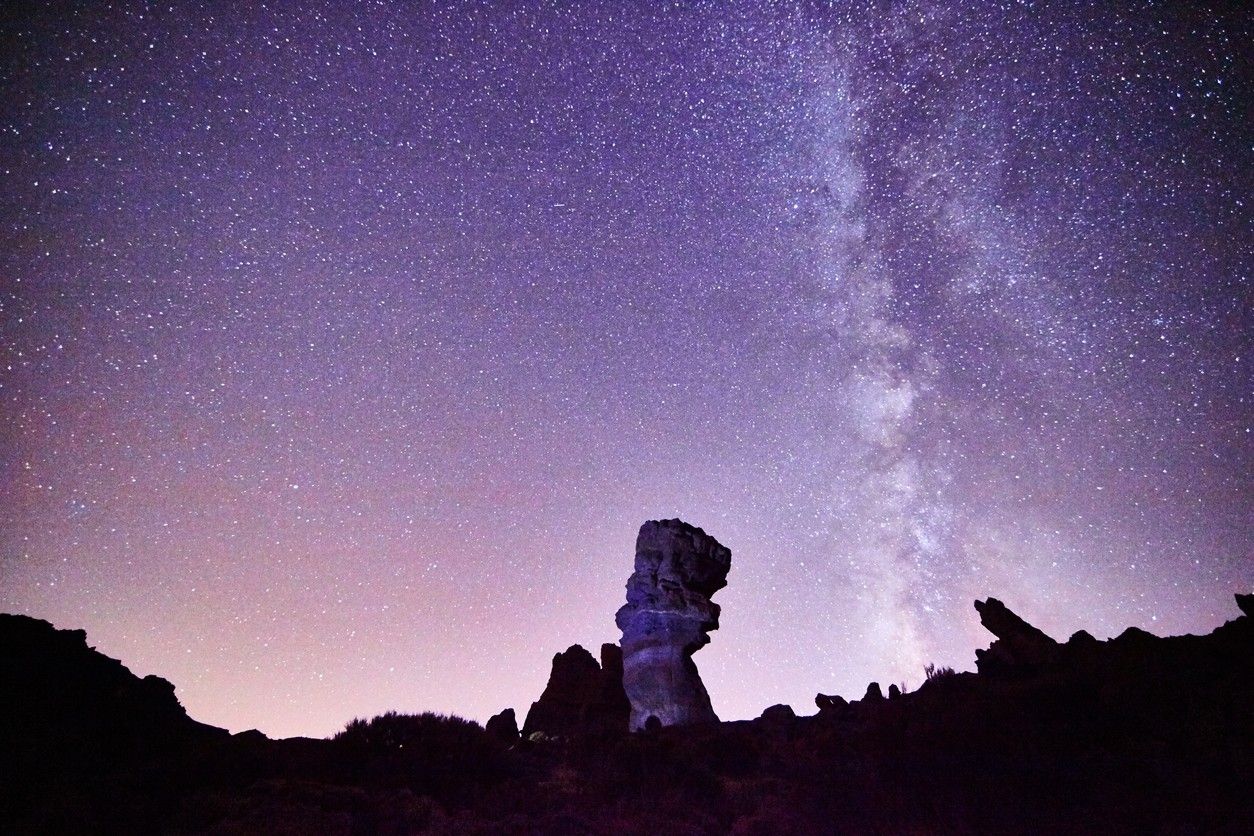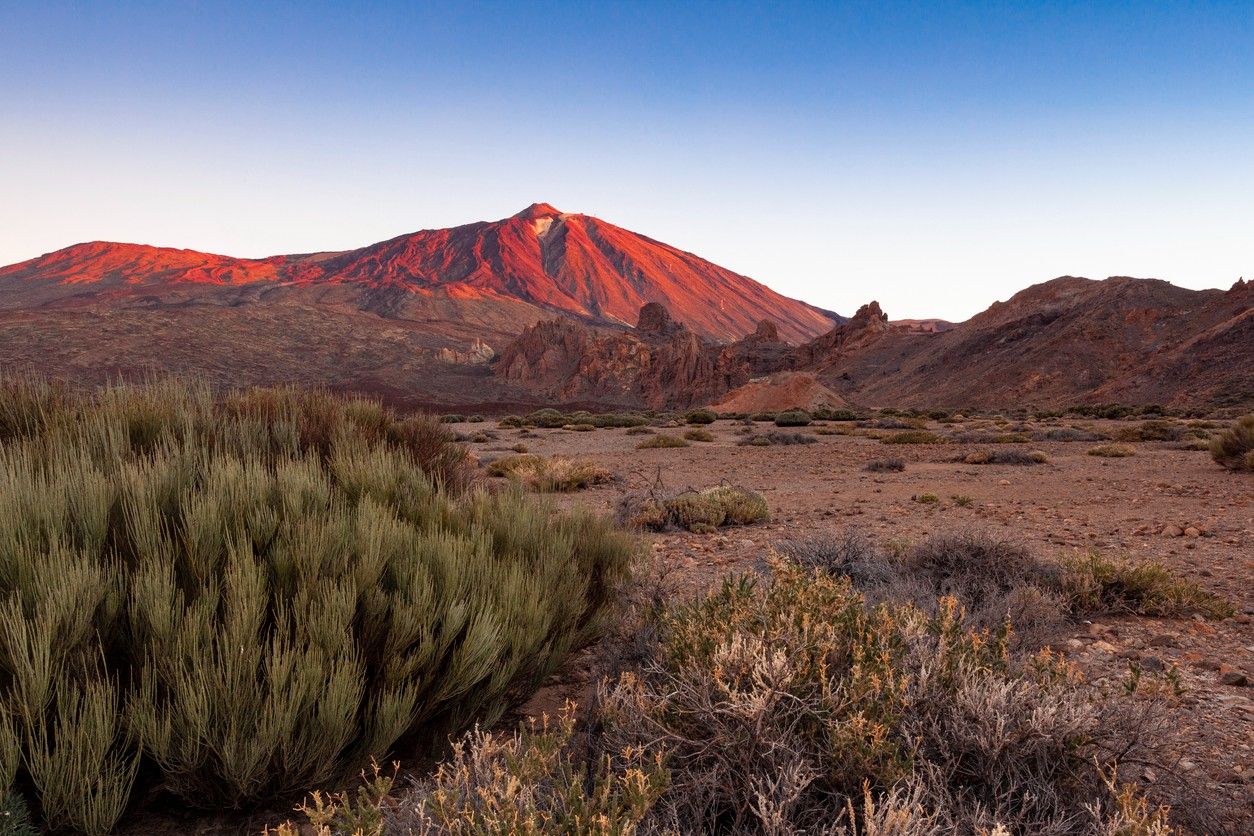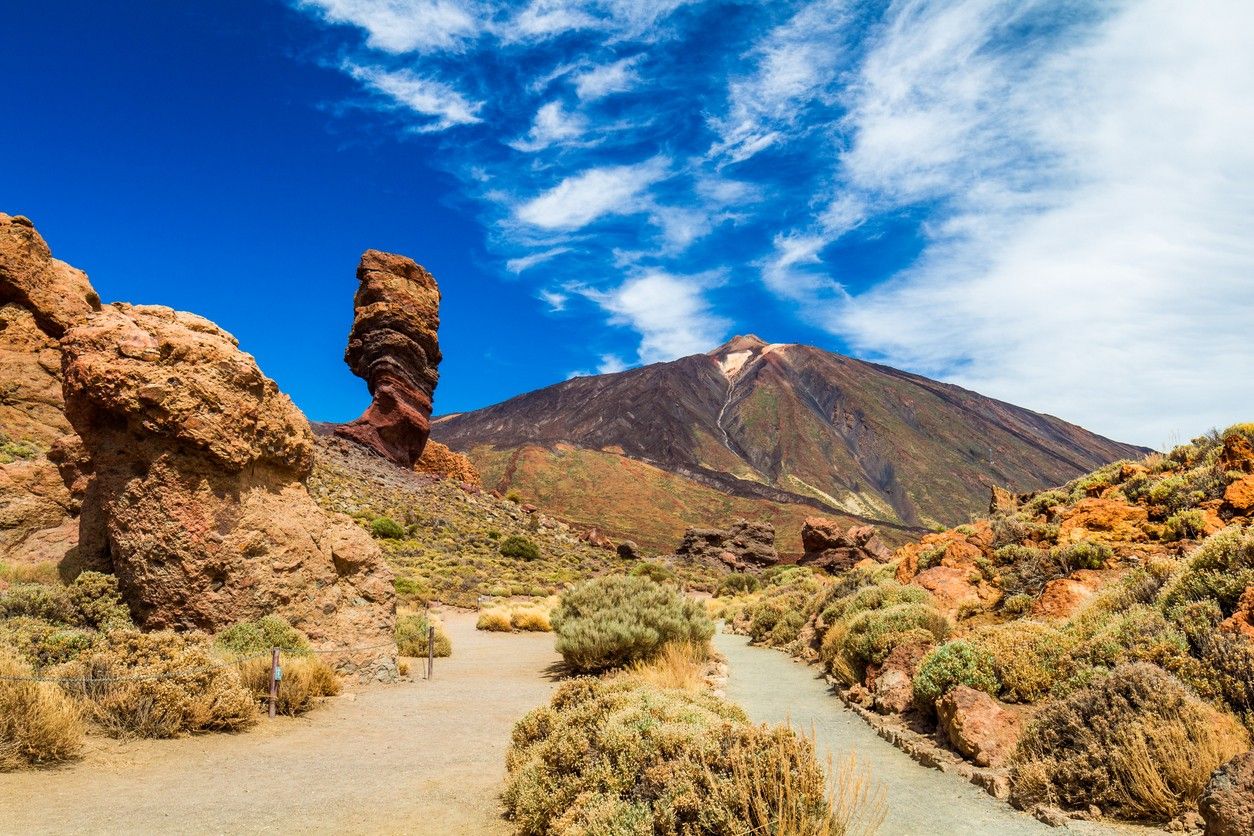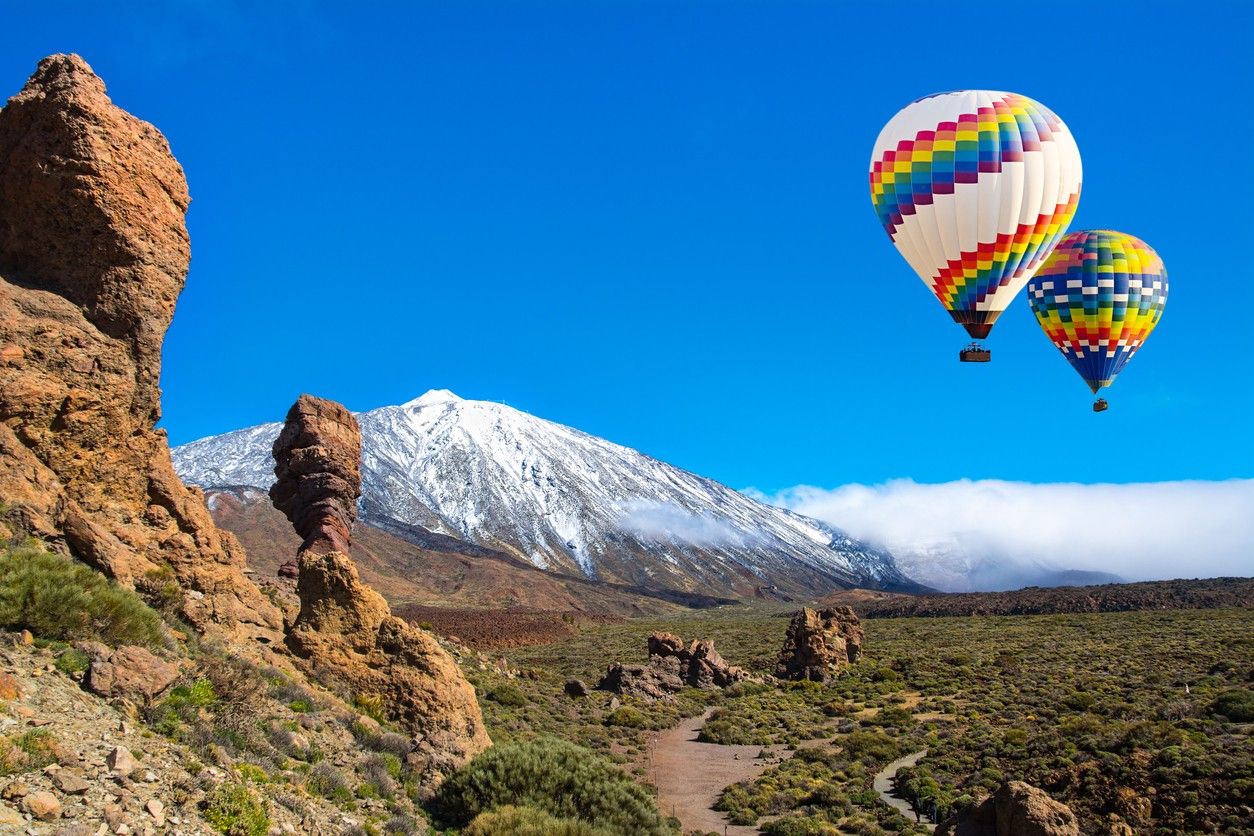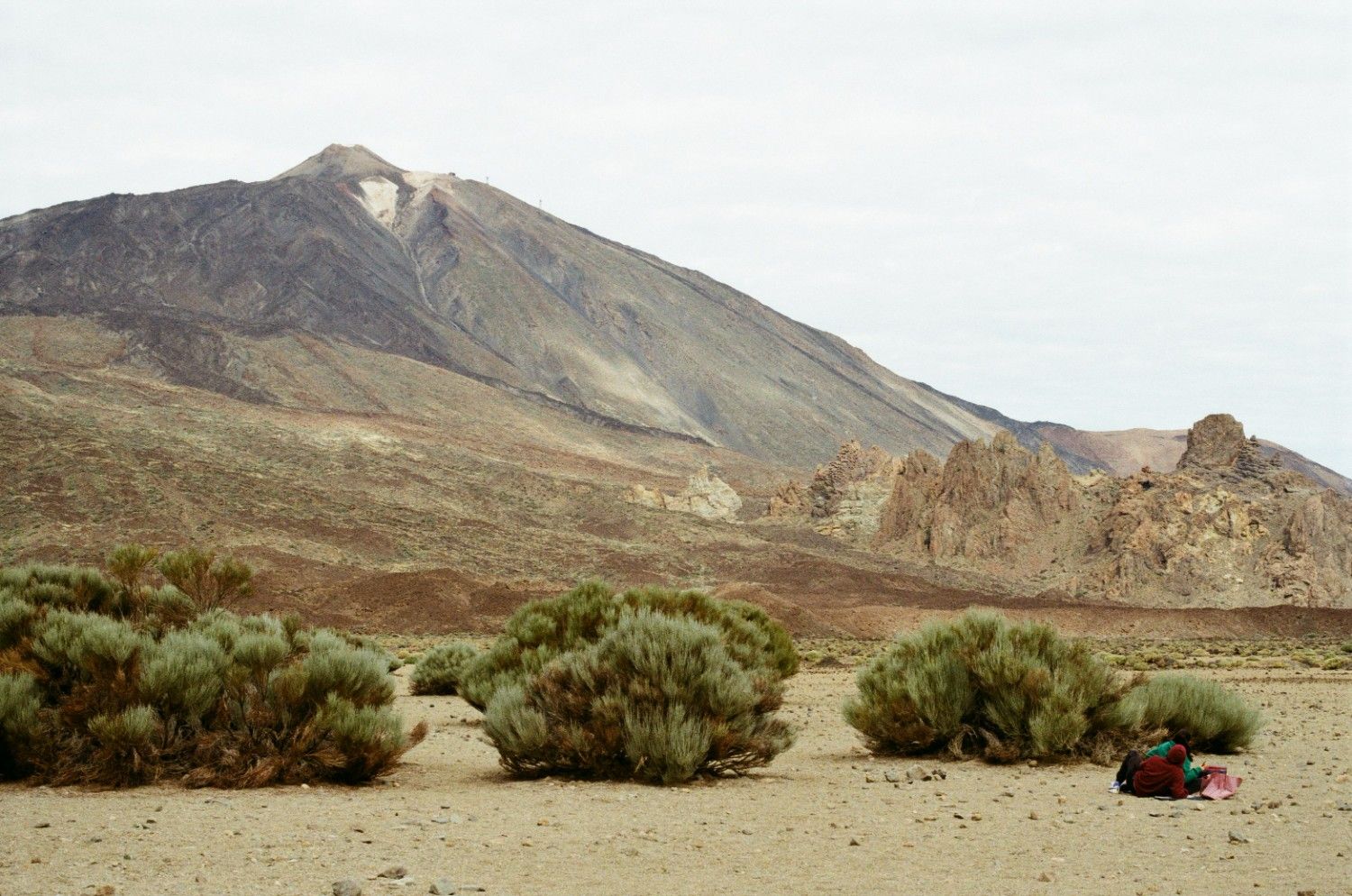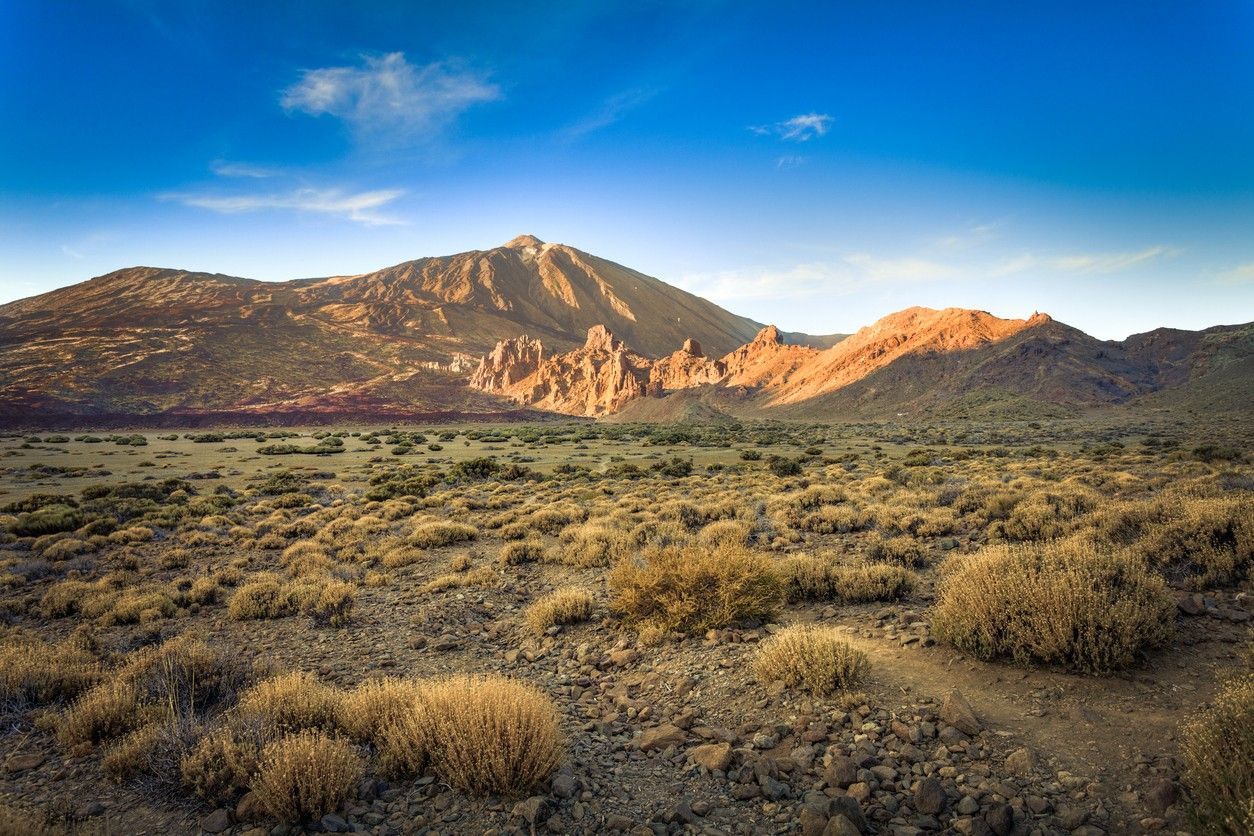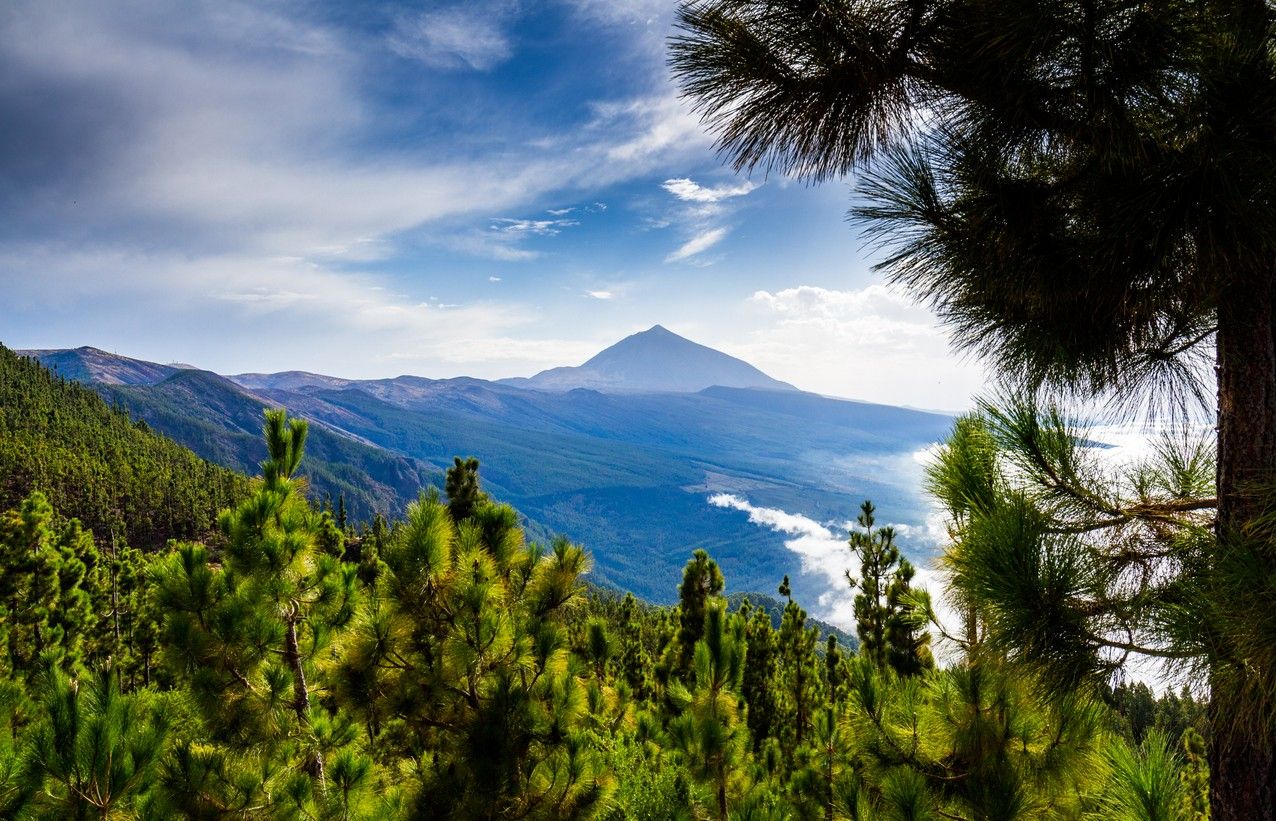Teide National Park is a captivating natural wonder nestled in the heart of Tenerife, one of the Canary Islands. This UNESCO World Heritage Site boasts a breathtaking landscape dominated by Spain's highest peak, Mount Teide, a magnificent volcanic marvel. Spanning an expansive 18,990 hectares, Teide National Park offers an unparalleled opportunity to immerse yourself in the awe-inspiring beauty of nature. From rugged volcanic terrain to tranquil pine forests, this park is a true gem for outdoor enthusiasts, nature lovers, and those seeking a unique and unforgettable experience. The otherworldly landscapes of the Las Cañadas caldera, the park's iconic volcanic crater, are a striking contrast to the lush pine forests that blanket the slopes of Mount Teide. The park's volcanic origins have shaped a terrain that is both captivating and thought-provoking, inviting visitors to explore and unravel the secrets of its geological past. One of the park's most alluring features is the opportunity to ascend Mount Teide itself. Standing at an impressive 3,718 meters (12,198 feet) above sea level, this dormant volcanic peak offers jaw-dropping vistas that stretch across the entire island and beyond.
Hiking Trails in Teide National Park
Teide National Park is a hiker's paradise, offering a network of well-maintained trails that cater to all skill levels. From challenging multi-day treks to strolls through pine forests, the park's hiking opportunities are as diverse as its landscapes.
Ruta de los Volcanes
The Ruta de los Volcanes (Route of the Volcanoes) is one of the most iconic and challenging hiking trails in Teide National Park. This 13-kilometer (8-mile) loop trail takes hikers on an unforgettable journey through the heart of the Las Cañadas caldera, offering unparalleled views of the park's volcanic landscapes. The trailhead for the Ruta de los Volcanes is located at the Montaña Blanca car park, situated at an elevation of 2,356 meters (7,730 feet) above sea level. From here, the trail winds its way across the caldera floor, passing by a series of impressive volcanic formations, including the Huevo Monde (Mundo's Egg), a distinctive lava bomb formation. As you continue along the trail, you'll be treated to breathtaking vistas of the Teide-Pico Viejo stratovolcano complex, with its towering peaks and ridges. The trail also offers up-close encounters with a variety of volcanic features, such as lava tubes, cinder cones, and intricate patterns formed by solidified lava flows.
One of the highlights of the Ruta de los Volcanes is the opportunity to climb to the summit of the Pico Viejo volcano, standing at an impressive 3,135 meters (10,285 feet) above sea level. This challenging ascent rewards hikers with panoramic views of the entire caldera and the surrounding peaks of Tenerife. The trail is well-marked and maintained, but it's important to note that it's a strenuous hike that can take between 5 to 6 hours to complete, depending on your pace and the number of stops you make along the way. Proper hiking gear, including sturdy footwear, layered clothing, and plenty of water and snacks, is essential for tackling this challenging but rewarding trail.
Shorter Hiking Trails
Teide National Park offers a diverse array of shorter trails that meander through pine forests, scenic overlooks, and volcanic landscapes. These trails provide an excellent opportunity to immerse yourself in the park's natural beauty without undertaking a strenuous multi-day trek.
Sendero de Los Roques de García — This 6-kilometer (3.7-mile) trail winds through the park's lush pine forests and offers stunning views of Mount Teide and the surrounding volcanic landscapes. The trailhead is located near the Parador de Las Cañadas del Teide hotel.
Sendero Siete Cañadas — Spanning a distance of 4.5 kilometres (2.8 miles), this trail takes hikers through the heart of the Las Cañadas caldera, offering breathtaking vistas of the volcanic terrain. The trailhead is accessible from the Montaña Blanca car park.
Sendero Naciente de Tauce — This 3.2-kilometer (2-mile) loop trail meanders through a lush pine forest and features a scenic viewpoint overlooking the Las Cañadas caldera. The trailhead is located near the Montaña Blanca car park.
Sendero de Las Narices del Teide — This 3.5-kilometre (2.2-mile) trail offers a unique perspective of Mount Teide, as it winds around the base of the volcano, providing views of the iconic rock formations known as "Las Narices del Teide" (The Noses of Teide). The trailhead is accessible from the Montaña Blanca car park.
Sendero de los Azulejos — This 2.8-kilometer (1.7-mile) trail takes hikers through a colorful volcanic landscape, featuring stunning rock formations and patterns created by oxidised minerals. The trailhead is located near the Parador de Las Cañadas del Teide hotel.
Sendero del Portillo — This 4-kilometer (2.5-mile) trail offers panoramic views of the Teide-Pico Viejo stratovolcano complex and the surrounding caldera. The trailhead is accessible from the Montaña Blanca car park.
Roques de García
The Roques de García is a collection of striking rock formations that have become an iconic landmark within Teide National Park. These towering pinnacles, sculpted by millions of years of erosion, offer hikers a unique opportunity to witness the raw power of nature and explore the park's captivating geology up close. Located within the Las Cañadas caldera, the trailhead for the Roques de García hike begins at the Mirador de las Cañadas viewpoint, situated at an elevation of 2,356 meters (7,730 feet) above sea level. From here, hikers can embark on a moderate 3.5-kilometer (2.2-mile) out-and-back trail that winds its way through the volcanic landscape, leading directly to the base of the Roques de García. The tallest pinnacle stands at an impressive 60 meters (197 feet) high, dwarfing hikers and providing a striking contrast against the surrounding volcanic terrain.
One of the highlights of the Roques de García hike is the opportunity to explore the various nooks, crannies, and caves that have formed within the rock formations themselves. These natural shelters offer a unique perspective on the geology of the area and provide a glimpse into the powerful forces that have shaped these remarkable structures over time. Several shorter loop trails wind around the base of the Roques de García, offering different vantage points and perspectives of these geological wonders. Visitors are advised to stay on designated trails and exercise caution when approaching the rock formations, as the terrain can be uneven and rocky.
Stargazing in Teide National Park
Teide National Park is renowned for its exceptional stargazing opportunities, thanks to its high altitude, clear skies, and minimal light pollution. The park's unique location, combined with its status as a Starlight Reserve, makes it a prime destination for amateur and professional astronomers alike.
Mirador de las Estrellas
The Mirador de las Estrellas, or the Stargazing Viewpoint, is one of the most popular destinations within Teide National Park for those seeking an unforgettable stargazing experience. Located at an elevation of 2,356 meters (7,730 feet), this purpose-built observation deck offers unobstructed views of the night sky, making it an ideal spot for stargazers and astrophotographers alike. To reach the Mirador de las Estrellas, visitors can either hike along the Ruta de los Volcanes trail or take the more convenient option of driving to the designated parking area near the viewpoint. From the parking lot, it's a short walk to the observation deck itself.
The Mirador de las Estrella has a large, circular platform that provides ample space for setting up telescopes, cameras, and other stargazing equipment. The platform is strategically positioned to offer stunning views of the night sky, with minimal light pollution and clear, dark skies that are perfect for observing celestial wonders. On a clear night, visitors can expect to witness the Milky Way in all its glory, stretching across the inky black canvas like a shimmering river of stars. The viewpoint also offers excellent opportunities to spot planets, star clusters, and even distant galaxies, depending on the time of year and the positioning of celestial objects.
Guided Stargazing Tours
For those looking to enhance their stargazing experience and gain a deeper understanding of the night sky, Teide National Park offers a range of guided stargazing tours led by experienced astronomers and guides. These tours typically begin in the evening, with a short hike or drive to the Mirador de las Estrellas or another designated stargazing spot within the park. Once there, participants are provided with high-powered telescopes and other astronomical equipment, allowing them to observe celestial objects up close and in detail. Throughout the tour, the guides will share fascinating insights into the night sky, explaining the stories and myths behind various constellations, pointing out planets and other celestial bodies, and providing a deeper understanding of the cosmos. In addition to observing through telescopes, many stargazing tours also incorporate multimedia presentations and interactive activities, making them an engaging and educational experience for stargazers of all ages and skill levels..
Astrophotography Opportunities
With its dark skies, minimal light pollution, and stunning volcanic landscapes, Teide National Park is a true paradise for astrophotographers. The park offers numerous locations that serve as ideal backdrops for capturing breathtaking images of the night sky. One of the most popular spots for astrophotography is the Mirador de las Estrellas, where photographers can set up their equipment and capture the Milky Way arching over the iconic volcanic landscapes of the Las Cañadas caldera. Other prime locations include the Roques de García, where the towering rock formations provide a dramatic foreground for starry sky shots. To make the most of the astrophotography opportunities within the park, it's recommended to plan your visit during the new moon phase, when the skies are at their darkest and the Milky Way is most visible. Clear and stable weather conditions are also essential for capturing high-quality images of the night sky.
Teide National Park offers workshops and guided tours led by experienced photographers. These workshops can provide valuable insights into the techniques and equipment required for capturing stunning images of the cosmos, as well as tips on finding the best locations and composing compelling shots. Regardless of your skill level, the combination of Teide National Park's dark skies and awe-inspiring landscapes makes it a truly remarkable destination for astrophotographers, offering endless opportunities to capture the beauty and majesty of the night sky.
Exploring the Volcanic Landscapes of Teide National Park
Teide National Park's most prominent feature is its volcanic landscape, a testament to the powerful geological forces shaping this remarkable destination over millions of years. The park offers a captivating glimpse into the Earth's fiery past, from towering rock formations to vast lava fields.
Las Cañadas Caldera
The Las Cañadas caldera is the centrepiece of Teide National Park's volcanic landscape and one of the most impressive geological features on the island of Tenerife. This massive volcanic crater spans an impressive 16 kilometres (10 miles) in diameter and was formed by a series of colossal eruptions that occurred millions of years ago. Visitors can access the caldera from several points within the park, with the most popular entry point being the Montaña Blanca car park, located at an elevation of 2,356 meters (7,730 feet) above sea level. From here, hikers can embark on a variety of trails that wind their way across the caldera floor, offering unparalleled views of the surrounding volcanic peaks and ridges. One of the most iconic features within the caldera is the Teide-Pico Viejo stratovolcano complex, which dominates the skyline with its towering peaks and distinctive shape. This impressive volcanic structure is the result of numerous eruptions throughout millions of years, with the most recent activity occurring in the late 18th century.
As you explore the caldera, you'll have the opportunity to witness a variety of volcanic formations, including cinder cones, lava flows, and intricate patterns created by solidified lava. The stark contrast between the black, jagged volcanic terrain and the vibrant vegetation that has managed to take root in the harsh environment is truly breathtaking. The Las Cañadas caldera also offers several viewpoints and scenic overlooks, such as the Mirador de las Cañadas and the Mirador de la Ruleta, which provide panoramic vistas of the entire caldera and the surrounding peaks.
Roques de los Muchachos
The Roques de los Muchachos (Rocks of the Young Men) is a striking geological formation that stands as one of the most iconic landmarks within Teide National Park. Located within the Las Cañadas caldera, this cluster of towering rock pinnacles has been sculpted by millions of years of erosion, resulting in a breathtaking display of nature's power and artistry. The trailhead to access the Roques de los Muchachos is located near the Parador de Las Cañadas del Teide, a historic hotel situated at 2,152 meters (7,060 feet) above sea level. From here, hikers can embark on a moderate 3.5-kilometer (2.2-mile) out-and-back trail that winds its way through the volcanic landscape, offering stunning vistas of the Roques de los Muchachos along the way. As you approach the rock formations, their imposing stature and unique shapes become truly apparent. These towering pinnacles, some reaching heights of up to 30 meters (98 feet), have earned their nickname due to their resemblance to a group of petrified warriors standing guard over the caldera.
One of the most iconic features of the Roques de los Muchachos is the "Roque Cinchado," a distinctive rock formation that appears to be cinched at the waist, creating a unique hourglass shape. This formation, along with the others in the cluster, provides a striking contrast to the surrounding volcanic terrain, making it a popular subject for photographers and artists alike. Several shorter loop trails weave through the Roques de los Muchachos, offering different perspectives and vantage points of these geological wonders. Visitors are advised to stay on designated trails and exercise caution when approaching the rock formations, as the terrain can be uneven and rocky..
Lava Fields and Cinder Cones
Teide National Park is home to an impressive array of lava fields and cinder cones, which serve as powerful reminders of the island's volcanic past. These features offer visitors a unique opportunity to witness the raw power of nature and gain a deeper understanding of the geological processes that have shaped the park's landscape. One of the most accessible and impressive lava fields within the park is the Llano de Ucanca, located just a short distance from the Montaña Blanca car park. This vast expanse of solidified lava covers an area of approximately 8 square kilometres (3 square miles) and was formed during the eruptions of the Teide-Pico Viejo volcanic complex. The surreal landscape of twisted and contorted lava formations was created as the molten rock cooled and solidified. The stark contrast between the black, jagged lava and the surrounding vegetation creates a striking visual spectacle that is truly unique to Teide National Park.
Another notable feature within the park is the Chahorra cinder cone, a well-preserved volcanic cone located near the Montaña Blanca car park. This impressive cone stands at a height of 120 meters (394 feet) and offers visitors the opportunity to hike to the rim and peer into the crater itself. For those interested in guided tours, the park offers several options that focus specifically on exploring the lava fields and cinder cones. These tours are led by knowledgeable guides who can provide insights into the geological processes that created these features and share fascinating stories about the park's volcanic history.
Flora and Fauna of Teide National Park
While Teide National Park is best known for its volcanic landscapes, it is also home to a diverse array of plant and animal life that have adapted to thrive in this unique environment. From endemic species found nowhere else on Earth to resilient flora that clings to the rugged terrain, the park's biodiversity is a true marvel.
Endemic Plant Species
Teide National Park is home to a remarkable array of endemic plant species that have adapted to thrive in the park's unique and often harsh environments. One of the most iconic and beloved of these species is the Teide Violet (Viola cheiranthifolia), a delicate purple flower that can be found growing in the park's rocky crevices and high-altitude regions. The Teide Violet is endemic to Tenerife, meaning it is found nowhere else in the world. This hardy plant has evolved to survive in the park's harsh conditions, including extreme temperature fluctuations, high UV exposure, and limited water availability. Its deep purple petals and compact growth form make it a true symbol of resilience and a beloved emblem of the park. To see the Teide Violet in its natural habitat, visitors can embark on several hiking trails within the park, including the Sendero de los Roques de García and the Ruta de los Volcanes. These trails wind through the park's rocky terrain and offer excellent opportunities to spot the Teide Violet blooming in crevices and sheltered areas.
In addition to the Teide Violet, the park is also home to several other endemic plant species, including the Tenerife Bugloss (Anchusa teneriffae), a striking blue flower that grows on the park's volcanic slopes, and the Canary Island Pine (Pinus canariensis), a towering pine tree that forms lush forests on the park's lower elevations. These endemic plant species are not only a source of beauty and wonder but also play a crucial role in the park's ecosystem, providing food and shelter for various animal species and helping to stabilise the volcanic soils.
Bird Life
Teide National Park is a true haven for birdwatchers, boasting a diverse array of avian species, including several endemic and threatened birds. One of the most sought-after and iconic species found within the park is the Tenerife Blue Chaffinch (Fringilla teydea), a vibrant blue bird that is found exclusively on the island of Tenerife. The Tenerife Blue Chaffinch can be spotted flitting through the park's pine forests and rocky outcrops, often seen foraging for insects and seeds among the vegetation. Its striking blue plumage and melodic song make it a true highlight for birdwatchers and nature enthusiasts alike.
Another endemic bird species found within the park is the Tenerife Goldcrest (Regulus teneriffae), a tiny insectivorous bird that inhabits the park's pine forests. With its bright yellow crest and distinctive high-pitched call, this diminutive bird is a delight to observe and a testament to the unique biodiversity found on the island. Teide National Park is also home to a variety of other birds, including the Barbary Partridge (Alectoris barbara), the Canary Islands Chiffchaff (Phylloscopus canariensis), and the Berthelot's Pipit (Anthus berthelotii), among others. To maximise your chances of spotting these avian wonders, it's recommended to embark on guided birdwatching tours led by experienced guides who can identify the various species and share insights into their behaviours and habitats. These tours often take place early in the morning or late in the afternoon, when birds are most active.
Teide National Park is a true haven for birdwatchers, boasting a diverse array of avian species, including several endemic and threatened birds. One of the most sought-after and iconic species found within the park is the Tenerife Blue Chaffinch (Fringilla teydea), a vibrant blue bird that is found exclusively on the island of Tenerife. The Tenerife Blue Chaffinch can be spotted flitting through the park's pine forests and rocky outcrops, often seen foraging for insects and seeds among the vegetation. Its striking blue plumage and melodic song make it a true highlight for birdwatchers and nature enthusiasts alike.
Another endemic bird species found within the park is the Tenerife Goldcrest (Regulus teneriffae), a tiny insectivorous bird that inhabits the park's pine forests. With its bright yellow crest and distinctive high-pitched call, this diminutive bird is a delight to observe and a testament to the unique biodiversity found on the island. Teide National Park is also home to a variety of other birds, including the Barbary Partridge (Alectoris barbara), the Canary Islands Chiffchaff (Phylloscopus canariensis), and the Berthelot's Pipit (Anthus berthelotii), among others. To maximise your chances of spotting these avian wonders, it's recommended to embark on guided birdwatching tours led by experienced guides who can identify the various species and share insights into their behaviours and habitats. These tours often take place early in the morning or late in the afternoon, when birds are most active.
Visitor Information and Practical Tips
To ensure a safe and enjoyable visit to Teide National Park, it is essential to plan and familiarise yourself with the park's regulations and practical information.
Obtaining Park Permits — One of the most important things to note is that all visitors must obtain a permit to enter the park. These permits can be obtained online or at the park's visitor centres and are essential for controlling the number of visitors and minimising the impact on the park's fragile ecosystems.
Transportation and Parking — When it comes to transportation, visitors have several options. While the park does have designated parking areas, many choose to take advantage of the public transportation options available. Regular bus services connect the park with various towns and cities on the island, making it easy to access the park without a personal vehicle.
Guided Tours and Educational Programs — For those interested in guided tours or educational programs, the park offers a range of options led by experienced guides and naturalists. These tours provide valuable insights into the park's geology, ecology, and cultural significance, enhancing the overall visitor experience.
Altitude Considerations — It is also important to note that Teide National Park is a high-altitude destination, with many hiking trails and viewpoints located at elevations above 2,000 meters (6,562 feet). Visitors should be prepared for the potential effects of altitude sickness and take necessary precautions, such as staying hydrated and allowing for proper acclimatisation.
Weather and Packing Essentials — Finally, visitors should keep in mind that the park's weather can be unpredictable, with temperatures ranging from warm and sunny to cool and windy, depending on the time of year and elevation. Proper hiking attire, including sturdy footwear, layered clothing, and sun protection, is essential for a comfortable and safe visit.
By following these practical tips and guidelines, visitors can fully immerse themselves in the natural wonders of Teide National Park while minimising their impact on this precious and unique destination.
Related articles

Let us know you agree to cookies
We use marketing, analytical and functional cookies as well as similar technologies to give you the best experience. Third parties, including social media platforms, often place tracking cookies on our site to show you personalised adverts outside of our website.
We store your cookie preferences for two years and you can edit your preferences via ‘manage cookies’ or through the cookie policy at the bottom of every page. For more information, please see our cookie policy.

